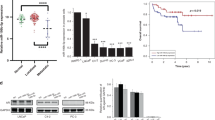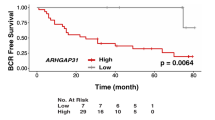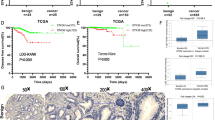Abstract
Metastasis is associated with the loss of epithelial features and the acquisition of mesenchymal characteristics and invasive properties by tumor cells, a process known as epithelial to mesenchymal transition (EMT). Snail expression, through nuclear factor (NF)-κB activation, is an EMT determinant. The proteasome inhibitor, NPI-0052, induces the metastasis tumor suppressor/immune surveillance cancer gene, Raf kinase inhibitor protein (RKIP), via NF-κB inhibition. We hypothesized that NPI-0052 may inhibit Snail expression and, consequently, the metastatic phenotype in DU-145 prostate cancer cells. Cell treatment with NPI-0052 induced E-cadherin and inhibited Snail expression and both tumor cell invasion and migration. Inhibition of Snail inversely correlated with the induction of RKIP. The underlying mechanism of NPI-0052-induced inhibition of the metastatic phenotype was corroborated by: (1) treatment with Snail siRNA in DU-145 inhibited EMT and, in contrast, overexpression of Snail in the nonmetastatic LNCaP cells induced EMT, (2) NPI-0052-induced repression of Snail via inhibition of NF-κB was corroborated by the specific NF-κB inhibitor DHMEQ and (3) RKIP overexpression mimicked NPI-0052 in the inhibition of Snail and EMT. These findings demonstrate, for the first time, the role of NPI-0052 in the regulation of EMT via inhibition of NF-κB and Snail and induction of RKIP.
This is a preview of subscription content, access via your institution
Access options
Subscribe to this journal
Receive 50 print issues and online access
$259.00 per year
only $5.18 per issue
Buy this article
- Purchase on Springer Link
- Instant access to full article PDF
Prices may be subject to local taxes which are calculated during checkout







Similar content being viewed by others
Abbreviations
- DHMEQ:
-
dehydroxymethylepoxyquinomicin
- FBS:
-
fetal bovine serum
- FITC:
-
fluorescein isothiocyanate
- GAPDH:
-
glyceraldehydes-3-phosphate dehydrogenase (G-3-PDH)
- NF-κB:
-
nuclear factor-kB
- PBS:
-
phosphate-buffered saline
- RFU:
-
relative fluorescence units
- RPE:
-
R-phycoerythrin
References
Ahn KS, Sethi G, Chao TH, Neuteboom ST, Chaturvedi MM, Palladino MA et al. (2007). Salinosporamide A (NPI-0052) potentiates apoptosis, suppresses osteoclastogenesis, and inhibits invasion through down-modulation of NF-kappaB regulated gene products. Blood 110: 2286–2295.
Barbera MJ, Puig I, Dominguez D, Julien-Grille S, Guaita-Esteruelas S, Peiro S et al. (2004). Regulation of Snail transcription during epithelial to mesenchymal transition of tumor cells. Oncogene 23: 7345–7354.
Baritaki S, Katsman A, Chatterjee D, Yeung KC, Spandidos DA, Bonavida B . (2007). Regulation of tumor cell sensitivity to TRAIL-induced apoptosis by the metastatic suppressor Raf kinase inhibitor protein via Yin Yang 1 inhibition and death receptor 5 up-regulation. J Immunol 179: 5441–5453.
Baritaki S, Suzuki E, Umezawa K, Spandidos DA, Berenson J, Daniels TR et al. (2008). Inhibition of Yin Yang 1-dependent repressor activity of DR5 transcription and expression by the novel proteasome inhibitor NPI-0052 contributes to its TRAIL-enhanced apoptosis in cancer cells. J Immunol 180: 6199–6210.
Beach S, Tang H, Park S, Dhillon AS, Keller ET, Kolch W et al. (2008). Snail is a repressor of RKIP transcription in metastatic prostate cancer cells. Oncogene 27: 2243–2248.
Blanco MJ, Moreno-Bueno G, Sarrio D, Locascio A, Cano A, Palacios J et al. (2002). Correlation of Snail expression with histological grade and lymph node status in breast carcinomas. Oncogene 21: 3241–3246.
Cano A, Perez-Moreno MA, Rodrigo I, Locascio A, Blanco MJ, del Barrio MG et al. (2000). The transcription factor snail controls epithelial-mesenchymal transitions by repressing E-cadherin expression. Nat Cell Biol 2: 76–83.
Chatterjee D, Bai Y, Wang Z, Beach S, Mott S, Roy R et al. (2004). RKIP sensitizes prostate and breast cancer cells to drug-induced apoptosis. J Biol Chem 279: 17515–17523.
Chauhan D, Catley L, Li G, Podar K, Hideshima T, Velankar M et al. (2005). A novel orally active proteasome inhibitor induces apoptosis in multiple myeloma cells with mechanisms distinct from Bortezomib. Cancer Cell 8: 407–419.
Chauhan D, Hideshima T, Anderson KC . (2006). A novel proteasome inhibitor NPI-0052 as an anticancer therapy. Br J Cancer 95: 961–965.
Chauhan D, Singh A, Brahmandam M, Podar K, Hideshima T, Richardson P et al. (2008). Combination of proteasome inhibitors bortezomib and NPI-0052 trigger in vivo synergistic cytotoxicity in multiple myeloma. Blood 111: 1654–1664.
Condeelis J, Pollard JW . (2006). Macrophages: obligate partners for tumor cell migration, invasion, and metastasis. Cell 124: 263–266.
Cusack Jr JC, Liu R, Xia L, Chao TH, Pien C, Niu W et al. (2006). NPI-0052 enhances tumoricidal response to conventional cancer therapy in a colon cancer model. Clin Cancer Res 12: 6758–6764.
Dangi-Garimella S, Yun J, Eves EM, Newman M, Erkeland SJ, Hammond SM et al. (2009). Raf kinase inhibitory protein suppresses a metastasis signalling cascade involving LIN28 and let-7. EMBO J 28: 347–358.
De Craene B, van Roy F, Berx G . (2005). Unraveling signalling cascades for the Snail family of transcription factors. Cell Signal 17: 535–547.
Dominguez D, Montserrat-Sentis B, Virgos-Soler A, Guaita S, Grueso J, Porta M et al. (2003). Phosphorylation regulates the subcellular location and activity of the snail transcriptional repressor. Mol Cell Biol 23: 5078–5089.
Elloul S, Silins I, Trope CG, Benshushan A, Davidson B, Reich R . (2006). Expression of E-cadherin transcriptional regulators in ovarian carcinoma. Virchows Arch 449: 520–528.
Fenical W, Jensen PR, Palladino MA, Lam KS, Lloyd GK, Potts BC . (2009). Discovery and development of the anticancer agent salinosporamide A (NPI-0052). Bioorg Med Chem 17: 2175–2180.
Fu Z, Kitagawa Y, Shen R, Shah R, Mehra R, Rhodes D et al. (2006). Metastasis suppressor gene Raf kinase inhibitor protein (RKIP) is a novel prognostic marker in prostate cancer. Prostate 66: 248–256.
Fu Z, Smith PC, Zhang L, Rubin MA, Dunn RL, Yao Z et al. (2003). Effects of raf kinase inhibitor protein expression on suppression of prostate cancer metastasis. J Natl Cancer Inst 95: 878–889.
Garcia de Herreros A . (2001) In: Common Molecules in Development and Carcinogenesis. Juan March Foundation: Madrid, Spain.
Granovsky AE, Rosner MR . (2008). Raf kinase inhibitory protein: a signal transduction modulator and metastasis suppressor. Cell Res 18: 452–457.
Hagan S, Al-Mulla F, Mallon E, Oien K, Ferrier R, Gusterson B et al. (2005). Reduction of Raf-1 kinase inhibitor protein expression correlates with breast cancer metastasis. Clin Cancer Res 11: 7392–7397.
Inoue J, Gohda J, Akiyama T, Semba K . (2007). NF-kappaB activation in development and progression of cancer. Cancer Sci 98: 268–274.
Jiao W, Miyazaki K, Kitajima Y . (2002). Inverse correlation between E-cadherin and Snail expression in hepatocellular carcinoma cell lines in vitro and in vivo. Br J Cancer 86: 98–101.
Julien S, Puig I, Caretti E, Bonaventure J, Nelles L, van Roy F et al. (2007). Activation of NF-kappaB by Akt upregulates Snail expression and induces epithelium mesenchyme transition. Oncogene 26: 7445–7456.
Katsman A, Umezawa K, Bonavida B . (2007). Reversal of resistance to cytotoxic cancer therapies: DHMEQ as a chemo-sensitizing and immuno-sensitizing agent. Drug Resist Updat 10: 1–12.
LaBonne C, Bronner-Fraser M . (2000). Snail-related transcriptional repressors are required in Xenopus for both the induction of the neural crest and its subsequent migration. Dev Biol 221: 195–205.
Miller CP, Ban K, Dujka ME, McConkey DJ, Munsell M, Palladino M et al. (2007). NPI-0052, a novel proteasome inhibitor, induces caspase-8 and ROS-dependent apoptosis alone and in combination with HDAC inhibitors in leukemia cells. Blood 110: 267–277.
Minoo P, Zlobec I, Baker K, Tornillo L, Terracciano L, Jass JR et al. (2007). Loss of raf-1 kinase inhibitor protein expression is associated with tumor progression and metastasis in colorectal cancer. Am J Clin Pathol 127: 820–827.
Nieto MA . (2002). The snail superfamily of zinc-finger transcription factors. Nat Rev Mol Cell Biol 3: 155–166.
Odabaei G, Chatterjee D, Jazirehi AR, Goodglick L, Yeung K, Bonavida B . (2004). Raf-1 kinase inhibitor protein: structure, function, regulation of cell signaling, and pivotal role in apoptosis. Adv Cancer Res 91: 169–200.
Olmeda D, Jorda M, Peinado H, Fabra A, Cano A . (2007). Snail silencing effectively suppresses tumour growth and invasiveness. Oncogene 26: 1862–1874.
Pantel K, Brakenhoff RH, Brandt B . (2008). Detection, clinical relevance and specific biological properties of disseminating tumour cells. Nat Rev Cancer 8: 329–340.
Peinado H, Ballestar E, Esteller M, Cano A . (2004). Snail mediates E-cadherin repression by the recruitment of the Sin3A/histone deacetylase 1 (HDAC1)/HDAC2 complex. Mol Cell Biol 24: 306–319.
Roccaro AM, Leleu X, Sacco A, Jia X, Melhem M, Moreau AS et al. (2008). Dual targeting of the proteasome regulates survival and homing in Waldenstrom macroglobulinemia. Blood 111: 4752–4763.
Rosivatz E, Becker I, Specht K, Fricke E, Luber B, Busch R et al. (2002). Differential expression of the epithelial-mesenchymal transition regulators snail, SIP1, and twist in gastric cancer. Am J Pathol 161: 1881–1891.
Ruiz S, Krupnik Y, Keating M, Chandra J, Palladino M, McConkey D . (2006). The proteasome inhibitor NPI-0052 is a more effective inducer of apoptosis than bortezomib in lymphocytes from patients with chronic lymphocytic leukemia. Mol Cancer Ther 5: 1836–1843.
Shook D, Keller R . (2003). Mechanisms, mechanics and function of epithelial-mesenchymal transitions in early development. Mech Dev 120: 1351–1383.
Sloss CM, Wang F, Liu R, Xia L, Houston M, Ljungman D et al. (2008). Proteasome inhibition activates epidermal growth factor receptor (EGFR) and EGFR-independent mitogenic kinase signaling pathways in pancreatic cancer cells. Clin Cancer Res 14: 5116–5123.
Steeg PS . (2006). Tumor metastasis: mechanistic insights and clinical challenges. Nat Med 12: 895–904.
Sterz J, von Metzler I, Hahne JC, Lamottke B, Rademacher J, Heider U et al. (2008). The potential of proteasome inhibitors in cancer therapy. Expert Opin Investig Drugs 17: 879–895.
Thiery JP, Sleeman JP . (2006). Complex networks orchestrate epithelial-mesenchymal transitions. Nat Rev Mol Cell Biol 7: 131–142.
van de Stolpe A, Caldenhoven E, Stade BG, Koenderman L, Raaijmakers JA, Johnson JP et al. (1994). 12-O-tetradecanoylphorbol-13-acetate- and tumor necrosis factor alpha-mediated induction of intercellular adhesion molecule-1 is inhibited by dexamethasone. Functional analysis of the human intercellular adhesion molecular-1 promoter. J Biol Chem 269: 6185–6192.
Yang MH, Chang SY, Chiou SH, Liu CJ, Chi CW, Chen PM et al. (2007). Overexpression of NBS1 induces epithelial-mesenchymal transition and co-expression of NBS1 and Snail predicts metastasis of head and neck cancer. Oncogene 26: 1459–1467.
Yeung K, Seitz T, Li S, Janosch P, McFerran B, Kaiser C et al. (1999). Suppression of Raf-1 kinase activity and MAP kinase signalling by RKIP. Nature 401: 173–177.
Yeung KC, Rose DW, Dhillon AS, Yaros D, Gustafsson M, Chatterjee D et al. (2001). Raf kinase inhibitor protein interacts with NF-kappaB-inducing kinase and TAK1 and inhibits NF-kappaB activation. Mol Cell Biol 21: 7207–7217.
Yokoyama K, Kamata N, Hayashi E, Hoteiya T, Ueda N, Fujimoto R et al. (2001). Reverse correlation of E-cadherin and snail expression in oral squamous cell carcinoma cells in vitro. Oral Oncol 37: 65–71.
Zhou BP, Deng J, Xia W, Xu J, Li YM, Gunduz M et al. (2004). Dual regulation of Snail by GSK-3beta-mediated phosphorylation in control of epithelial-mesenchymal transition. Nat Cell Biol 6: 931–940.
Acknowledgements
This study was supported in part by the NIH/NCI research supplements CA107023-02S1, CA057152-13S1 and by Bodossaki Foundation postdoctoral fellowship (SB). We thank Chau Tran, Jose A Rodriguez and Haiming Chen for their help in the migration and invasion assays and the immunofluorescence microscopy. We also thank Dr Kazuo Umezawa for providing us with the NF-κB inhibitor DHMEQ. In addition, we thank Tiffany Chin, Katherine Wu and Erica Keng for helping in the preparation of this article.
Author information
Authors and Affiliations
Corresponding author
Rights and permissions
About this article
Cite this article
Baritaki, S., Chapman, A., Yeung, K. et al. Inhibition of epithelial to mesenchymal transition in metastatic prostate cancer cells by the novel proteasome inhibitor, NPI-0052: pivotal roles of Snail repression and RKIP induction. Oncogene 28, 3573–3585 (2009). https://doi.org/10.1038/onc.2009.214
Received:
Revised:
Accepted:
Published:
Issue Date:
DOI: https://doi.org/10.1038/onc.2009.214
Keywords
This article is cited by
-
Cytotoxicity of bismuth(III) dithiocarbamate derivatives by promoting a mitochondrial-dependent apoptotic pathway and suppressing MCF-7 breast adenocarcinoma cell invasion
JBIC Journal of Biological Inorganic Chemistry (2024)
-
Biological and therapeutic implications of RKIP in Gastrointestinal Stromal Tumor (GIST): an integrated transcriptomic and proteomic analysis
Cancer Cell International (2023)
-
Targeting Phenotypic Plasticity in Prostate Cancer
Current Molecular Biology Reports (2017)
-
The network of epithelial–mesenchymal transition: potential new targets for tumor resistance
Journal of Cancer Research and Clinical Oncology (2015)
-
SNAI1 is critical for the aggressiveness of prostate cancer cells with low E-cadherin
Molecular Cancer (2014)



